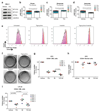Targeting mitochondrial oxidative phosphorylation eradicates therapy-resistant chronic myeloid leukemia stem cells
- PMID: 28920959
- PMCID: PMC5657469
- DOI: 10.1038/nm.4399
Targeting mitochondrial oxidative phosphorylation eradicates therapy-resistant chronic myeloid leukemia stem cells
Abstract
Treatment of chronic myeloid leukemia (CML) with imatinib mesylate and other second- and/or third-generation c-Abl-specific tyrosine kinase inhibitors (TKIs) has substantially extended patient survival. However, TKIs primarily target differentiated cells and do not eliminate leukemic stem cells (LSCs). Therefore, targeting minimal residual disease to prevent acquired resistance and/or disease relapse requires identification of new LSC-selective target(s) that can be exploited therapeutically. Considering that malignant transformation involves cellular metabolic changes, which may in turn render the transformed cells susceptible to specific assaults in a selective manner, we searched for such vulnerabilities in CML LSCs. We performed metabolic analyses on both stem cell-enriched (CD34+ and CD34+CD38-) and differentiated (CD34-) cells derived from individuals with CML, and we compared the signature of these cells with that of their normal counterparts. Through combination of stable isotope-assisted metabolomics with functional assays, we demonstrate that primitive CML cells rely on upregulated oxidative metabolism for their survival. We also show that combination treatment with imatinib and tigecycline, an antibiotic that inhibits mitochondrial protein translation, selectively eradicates CML LSCs both in vitro and in a xenotransplantation model of human CML. Our findings provide a strong rationale for investigation of the use of TKIs in combination with tigecycline to treat patients with CML with minimal residual disease.
Conflict of interest statement
E.G. is a Founder and Shareholder of MetaboMed Ltd. T.L.H. has previously received research support from Bristol-Myers Squibb and Novartis
Figures




References
-
- Druker BJ, et al. Five-year follow-up of patients receiving imatinib for chronic myeloid leukemia. N Engl J Med. 2006;355:2408–2417. - PubMed
-
- Graham SM, et al. Primitive, quiescent, Philadelphia-positive stem cells from patients with chronic myeloid leukemia are insensitive to STI571 in vitro. Blood. 2002;99:319–325. - PubMed
-
- Holyoake TL, Helgason GV. Do we need more drugs for chronic myeloid leukemia? Immunological reviews. 2015;263:106–123. - PubMed
MeSH terms
Substances
Grants and funding
LinkOut - more resources
Full Text Sources
Other Literature Sources
Medical
Research Materials
Miscellaneous

